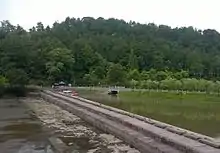Tashan Weir
Tashan Weir (Chinese: 它山堰; pinyin: Tuōshān yàn) also called Tuoshan Weir or Tuoshanyan[1] is an ancient dam that was erected under Emperor Tang Wenzong during the Tang Dynasty in 833. The dam is located in Tashanyan Village, Yinjiang Town, Haishu District, Ningbo, Zhejiang, China. Originally designed under the supervision of Wang Yuanwei, who was the administrator of Yin County, in an attempt to prevent tidal sea water from accessing the banks of the Fenghua River and to store water during periods of severe drought. The dam later became part of a large-scale irrigation system serving Ningbo City. This infrastructure is particularly notable because it is recognized as a historical site protected by the state.[2]
| 它山堰 | |
 | |
| Coordinates | 29.769607°N 121.347248°E |
|---|---|
| Location | Tashanyan Village, Yinjiang Town, Haishu District, Ningbo, Zhejiang, China |
| Designer | Wang Yuanwei |
| Type | Dam |
| Length | 110 metres (360 ft) |
| Completion date | 833 |
History
Prior to the dam's construction, the surrounding area regularly experienced devastating floods due to the torrential rains that would come every summer and autumn due to the local sub-tropical climate. Once it combined with the flat terrain and the high salt content of the Fenghua River, it decimated the crops and made the inhabitants suffer bouts of famine. To remedy this situation, the construction of Tashan Weir was decided by Wang Yuanwei, a magistrate originally from Shandong, and was completed in 833 with the aim of decreasing the risk of flooding and permanently removing salted water from arable land.
The dam was also used to divert water to two different directions. The first stream flows along the Nantang River, serves Dongqiao, Hengzhang, Beidu, Lishe, Shiqi and Duantang, then reaches the city of Ningbo intra-muros before pouring into the man-made Moon Lake (Chinese: 月湖; pinyin: Yuè hú) and Sun Lake (Chinese: 日湖; pinyin: Rì hú) which no longer exists today. The second flow goes up north, serving Xiaoxi, Meiyuan and Shenjiao.

In total, the hydraulic system of Tashan Weir (the dam, the two flows, and the ancillary facilities) has been irrigating nearly 16,000 hectares of land for centuries, and continues to do so even today. The Ningbo area experienced rapid growth due to the stability of water supply that the dam provided.
Construction
The dam is about 110 meters long and its top is approximately 5 meters wide. Its outer part is composed of roughly regular stones (2 to 3 meters long and 0.2 to 0.35 meters thick) while its internal part is made of a mixture of stone and wood. In order to consolidate the structure, molten iron was directly injected in some places. The dam was designed in such a way that it adjusts perfectly with the course of the river and is able to withstand risks associated with erosion over time. Maintenance and restructuring work were continuously carried out, from the imperial dynasties to nowadays.
The design of the facility ensured that, in cases of excessive rain, 70 percent of the flood water flows to the Zhang River (inner river) while the remaining 30 percent discharges to the Nantang River (outer river).[3] This proportion in the flow of water is reversed during periods of drought. The Tashan Weir was able to achieve this through the installation of water gates between the inner and outer rivers.
Legacy

Tashan Weir was officially declared on 13 January 1988 as a Major Historical and Cultural Site Protected at the National Level (Number 3-55). It is also recognized as one of the four most important water conservation projects of imperial or pre-imperial China, with the Zhengguo Canal, the Lingqu Canal, as well as Dujiangyan. A temple with a statue representing Wang Yuanwei and ten builders of Tashan Weir was built nearby and important ceremonies and cultural festivities are regularly held there.
Gallery
 View from the northern bank of the river
View from the northern bank of the river First edge of the dam
First edge of the dam Second edge of the dam
Second edge of the dam View from the west
View from the west View from the east
View from the east Holes where molten iron was introduced
Holes where molten iron was introduced Temple dedicated to Wang Yuanwei
Temple dedicated to Wang Yuanwei Stele marking the emplacement of the temple
Stele marking the emplacement of the temple Statue of Wang Yuanwei
Statue of Wang Yuanwei
See also
References
Citations
- The 它 of 它山堰 is read as "Tuō" and not as "Tā"
- angelakis, Andreas; Mays, Larry; Koutsoyiannis, Demetris; Mamassis, Nikos (2012). Evolution of Water Supply Through the Millennia. London: IWA Publishing. p. 198. ISBN 9781843395409.
- Angelakis et al., p. 198.
Bibliography
- Andreas N. Angelakis, Larry W. Mays, Demetris Koutsoyiannis, Nikos Mamassis, Evolution of Water Supply Through the Millennia.
- Han Zhang, China’s Local Entrepreneurial State and New Urban Spaces: Downtown.
- Yongxiang Lu, A History of Chinese Science and Technology, Volume 3.